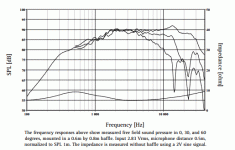Of course not. If you can smell the former it's too hot. But . . . what's the temperature coefficient of Copper, again (from say 20C to 80C)? What's that in dB?I do not accept that you can design out changes due to temperature and the system cannot be optimal at all temperatures.
less layers (ideally just one) around the coil the better to avoid the temperature and allow also a better cooling? But less BL for a bass driver e.g ?
Are there many speakers designers (maybe it's one of the basic rules?) who care about thermal issues when designing or is it low in the list because he has already a lot of trade offs to deal with ?
Sorry if a basic question...
Are there many speakers designers (maybe it's one of the basic rules?) who care about thermal issues when designing or is it low in the list because he has already a lot of trade offs to deal with ?
Sorry if a basic question...
I'm not going to do the calcs, you can if you want, but its certainly a greater % change than THD or IMD which most people (not me of course) obsess over.
If one deals in Pro they have always worried about thermal. It's rare in consumer, but, to me, the reasons given are not valid. Sure thermal compression is not a factor in a home listening room at typical levels, but that is exactly the point that I have been trying to make - that thermal modulation is just as big an issue in consumer as it is in pro because it happens at all listening levels.
If one deals in Pro they have always worried about thermal. It's rare in consumer, but, to me, the reasons given are not valid. Sure thermal compression is not a factor in a home listening room at typical levels, but that is exactly the point that I have been trying to make - that thermal modulation is just as big an issue in consumer as it is in pro because it happens at all listening levels.
Very interresting.... rememnber some readings about thermal issues in sound reproduction when you listen a low efficienty driver as mine (85 DB) more longer than 30 minutes (which is hard to do if you are listen to Aron Copland like I do now !): because the dynamics preaks are often and everywhere in the muic so the driver don't sucees to stay with an acceptable temperature... Surmise sealed design doesn't improve it. But I much prefer the sealed bass than the vented...
One way to avoid it is ESL design... but need strong amps... is it a problem with such design à la Hypex nowadays ?
But ESL is OB (never saw trys to make it cardioid with some carpet load behind it).... but here of course no controlled directivity : this the placement and the room who dictate the result ?!
a two cents reflexion for the beginners like I am... You specialists are difficult to follow but I'm in for a democratic dialog with poor minded people ! (oh my mirror... sorry defintly be in the oddest french audiofools ! 😉 I joke, no problem wit that, frenchs are hard to live with even with each others, we are in constant revolution hand have in a same time the will of science and engineering since centuries... like most of european countries btw !)
One way to avoid it is ESL design... but need strong amps... is it a problem with such design à la Hypex nowadays ?
But ESL is OB (never saw trys to make it cardioid with some carpet load behind it).... but here of course no controlled directivity : this the placement and the room who dictate the result ?!
a two cents reflexion for the beginners like I am... You specialists are difficult to follow but I'm in for a democratic dialog with poor minded people ! (oh my mirror... sorry defintly be in the oddest french audiofools ! 😉 I joke, no problem wit that, frenchs are hard to live with even with each others, we are in constant revolution hand have in a same time the will of science and engineering since centuries... like most of european countries btw !)
Last edited:
The link doesn't work right for me - can't see an actual speaker, so I can't comment. At any rate it was Eldam who made the claim, I don't know if it is true or not. Don't really care much either.
To be honest, Avantgarde probably don't care about you either. Especially when the loudspeaker is far from your concept;o) Further on, you don't seem to be serious when you comment something you haven't seen. But I suppose that "you don't really care"
It could be that writing is different than direct communicating…?
To be honest, Avantgarde probably don't care about you either. Especially when the loudspeaker is far from your concept;o) Further on, you don't seem to be serious when you comment something you haven't seen. But I suppose that "you don't really care"
It could be that writing is different than direct communicating…?
Please keep it civil. You don't have to agree but there's no need for individual insults either. This thread has been a great discussion and I'd like for it to continue that way.
Thank you
Please keep it civil. You don't have to agree but there's no need for individual insults either. This thread has been a great discussion and I'd like for it to continue that way.
Thank you
Well, sorry if it came out like an rude post. However it wasn't, there was a wink and I don't see it as a individual insult at all. Just pure facts!
Anyway, I'm buzzing out…
"I am not surprised that Avantgard copied my designs"
That's a statement indicating that they did indeed copy them- misworded perhaps but a pretty inflammatory accusation (and not true, they're using tractrix or spherical or some such, and it's a 3 way, and and and....) so I can see why peter reacted the way he did. Let's call it a misunderstanding and move on.
That's a statement indicating that they did indeed copy them- misworded perhaps but a pretty inflammatory accusation (and not true, they're using tractrix or spherical or some such, and it's a 3 way, and and and....) so I can see why peter reacted the way he did. Let's call it a misunderstanding and move on.
Gentlemen,
this statment came from me not from Earl Gedlee. For me the look is the same and the only one speaker I know near are the Gedlees.
But if you look at the Advangard (what I was the only one who listen it here !) : they are not the same :the Zero (I can not find a better name, bravo !) has a hole for a tweeter : it's a 3 ways. The medium waveguide has no foam cover... it's near but not the same. I will say the look is very attractiv like the touch : something near a rubber but harder. Just the feets are awfull ! It's a very directive speaker vertically. The bass are very muddy, I can testimonie about that as this is an active speaker from what the vendor told me... The mid & highs are smooth but the mid bass and bass after 3 musics I choose and I knew was a joke ! Don't think the room was involved. That's just a personal testimonie !
this statment came from me not from Earl Gedlee. For me the look is the same and the only one speaker I know near are the Gedlees.
But if you look at the Advangard (what I was the only one who listen it here !) : they are not the same :the Zero (I can not find a better name, bravo !) has a hole for a tweeter : it's a 3 ways. The medium waveguide has no foam cover... it's near but not the same. I will say the look is very attractiv like the touch : something near a rubber but harder. Just the feets are awfull ! It's a very directive speaker vertically. The bass are very muddy, I can testimonie about that as this is an active speaker from what the vendor told me... The mid & highs are smooth but the mid bass and bass after 3 musics I choose and I knew was a joke ! Don't think the room was involved. That's just a personal testimonie !
Thi may have already been mentioned. This is why folks in the Fullrange forum cross below 400Hz in a FAST implementation with a fullrange driver handling the critical 500Hz to 5kHz band where all the phase and spatial point source. coherency is important.
The problem is not being able to get high SPL levels with a typical fullrange driver. Recently rather sensitive and high power wide band drivers are changing this. Take for example the case of a 5in driver that goes from 300Hz to 15khz with up to 225watts rms and 95dB sensitivity. Couple that with a woofer XO below 400Hz and you have a system that doesn't have any XO in the critical human hearing range.
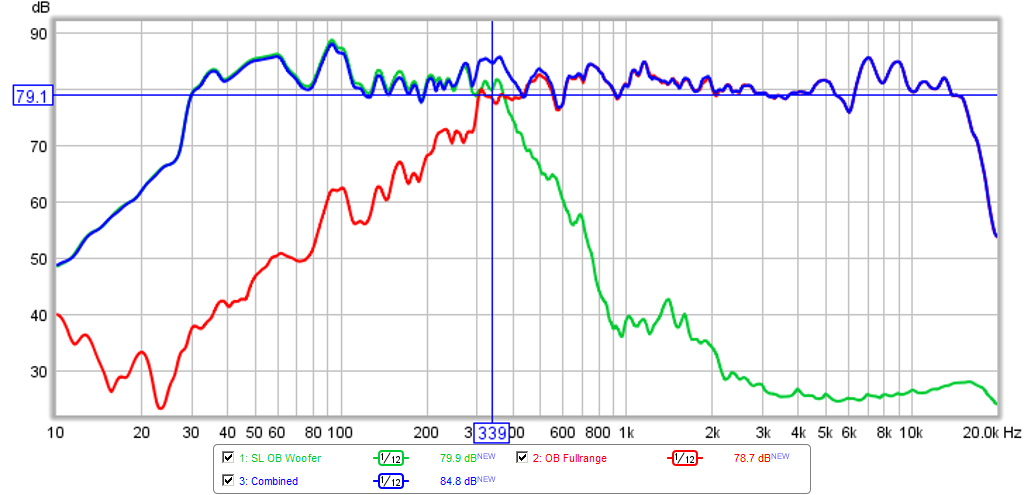
http://www.diyaudio.com/forums/full-range/259293-prv-5mr450-ndy-fast-applications-2.html#post3995448
The problem is not being able to get high SPL levels with a typical fullrange driver. Recently rather sensitive and high power wide band drivers are changing this. Take for example the case of a 5in driver that goes from 300Hz to 15khz with up to 225watts rms and 95dB sensitivity. Couple that with a woofer XO below 400Hz and you have a system that doesn't have any XO in the critical human hearing range.

http://www.diyaudio.com/forums/full-range/259293-prv-5mr450-ndy-fast-applications-2.html#post3995448
Except that one of the more audible amplifier problems is its performance at low signal levels due to poor crossover distortion problems. This problem is exacerbated by high efficiency speakers.
Yes, but what are you supposed to do about crossover distortion? There's not a lot you can do. It's either not there, a la class A or high bias class AB, or present, a la optimally biased class AB amplifier or you've got GM doubling from exiting the class A region of a high bias class AB.
The only real solution to this is to use high efficiency on the end of class A. A second decent solution is to use a high bias optimally biased class AB that rarely leaves it's class A region and when it does, it's only for the odd transient and with that design you don't get GM doubling. This of course requires specific tailoring to your system.
It would seem that the only good choice for a low biased optimally biased class AB amplifier would be to use low sensitivity speakers.
Well at least there are enough options out there to keep people occupied.
I personally use low power class A on the end of decent efficiency.
My tests on amps indicated that the amount of crossover distortion varied widely with no correlation to brand or cost. Chip amps were particularly good (as you might expect). But lets not get off on an amplifier tangent, things are tough enough as it is.
Thi may have already been mentioned. This is why folks in the Fullrange forum cross below 400Hz in a FAST implementation***
Take for example the case of a 5in driver that goes from 300Hz to 15khz***

http://www.diyaudio.com/forums/full-range/259293-prv-5mr450-ndy-fast-applications-2.html#post3995448
There's a reason those graphs are axial only. Polar maps would show what a bad idea a 5" wideband driver is. At least for mains. For surrounds and probably the new Dolby Atmos height speakers, a FAST thing is probably a pretty good compromise between simplicity and output.
Class D also doesn't exhibit crossover distortion.
No, but unless they are extremely good quality they do throw up a multitude of high order products, so you have to careful, again, about which ones you buy.
There's a reason those graphs are axial only. Polar maps would show what a bad idea a 5" wideband driver is.
Here is polar data for the same driver in a Nautaloss cabinet - does that look bad to you?
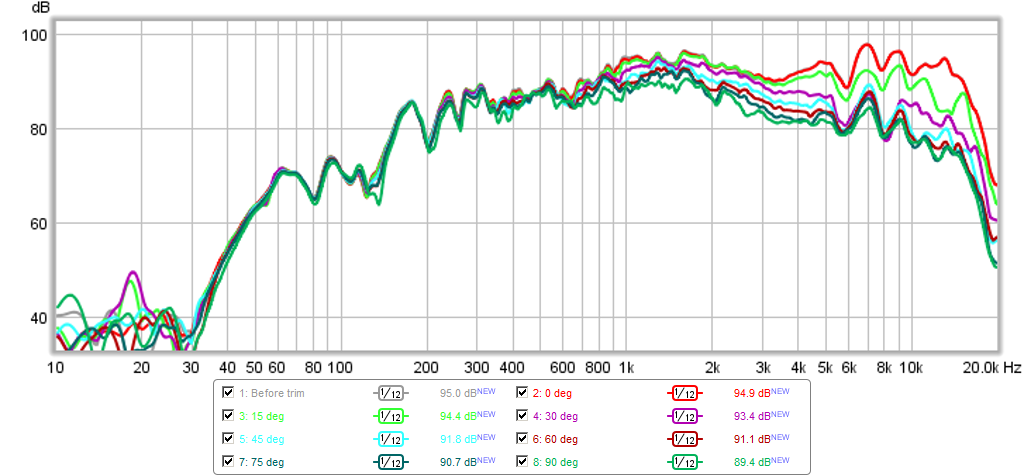
Compare to for example, an SB Acoustics SB26STAC soft dome tweeter as measured by J Bagby:
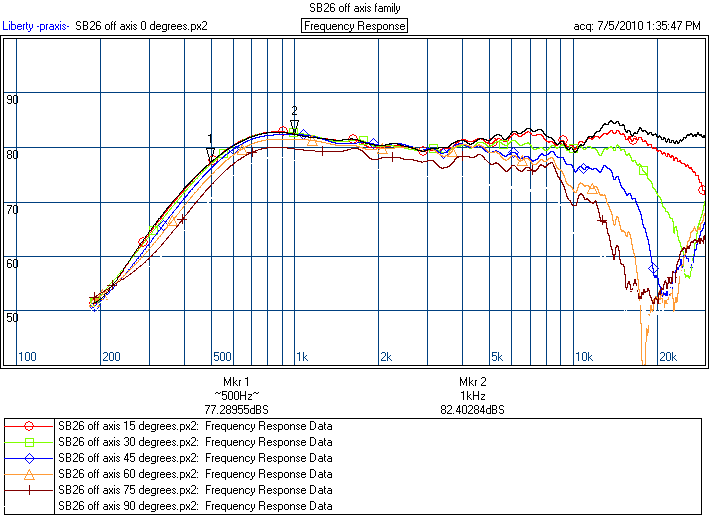
Or a SEAS 27TDFC dome tweeter:
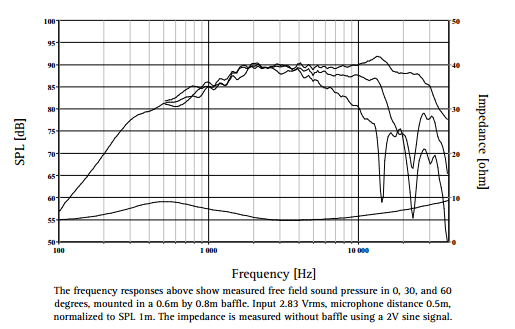
Oh, and did I mention that this driver has some pretty low distortion? Here are distortion figures at 94dB:
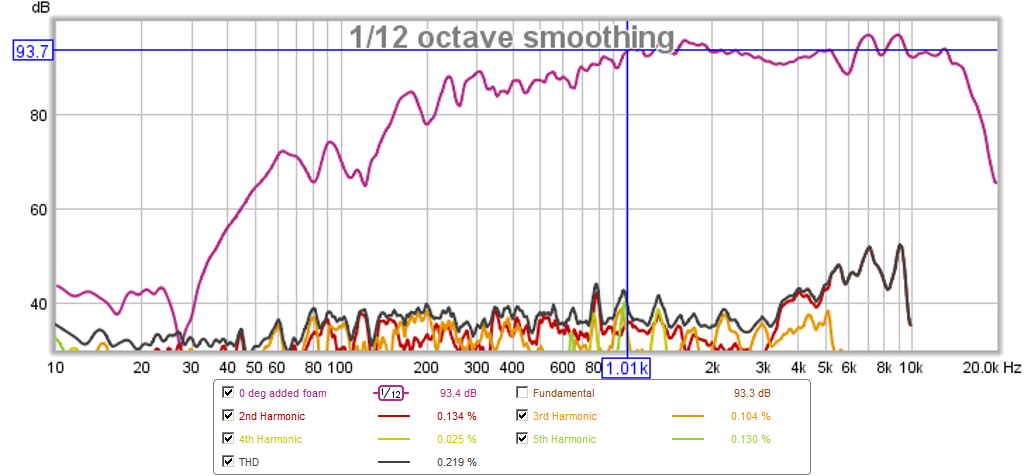
Attachments
Last edited:
Here is polar data for the same driver in a Nautaloss cabinet - does that look bad to you?

]
Actually it does, the cone breakups around 5khz -10khz is unacceptable for a high performance speakers
Last edited:
I agree if cone breakup of 8dB bothers you, but the advantage of point source phase/spatial coherence trumps this for me compared to multiways with a XO at 1 to 2 khz.
In any case, Pallas was claiming that a 5 in fullrange have bad polar response given that it was not shown.
In any case, Pallas was claiming that a 5 in fullrange have bad polar response given that it was not shown.
Here is polar data for the same driver in a Nautaloss cabinet - does that look bad to you?

Assuming the huge range between gridlines and thick lines of the FR trace weren't intended to conceal worse nasties, it's marginal - for a midrange crossed at ~2kHz with a steep lowpass and some notching to tame the breakup...
Here's an example of the axial FR and polar map for a well-designed small loudspeaker (6.5" mid and 1" tweeter on elliptical waveguide, designed and built by Dave Pellegrene):


Last edited:
If that's the Vifa TC9 then it isn't really a 5" driver, it's smaller than that. And I'd agree, from those polars it's off axis response is quite a bit better than you might think.
- Status
- Not open for further replies.
- Home
- Loudspeakers
- Multi-Way
- Why crossover in the 1-4khz range?
